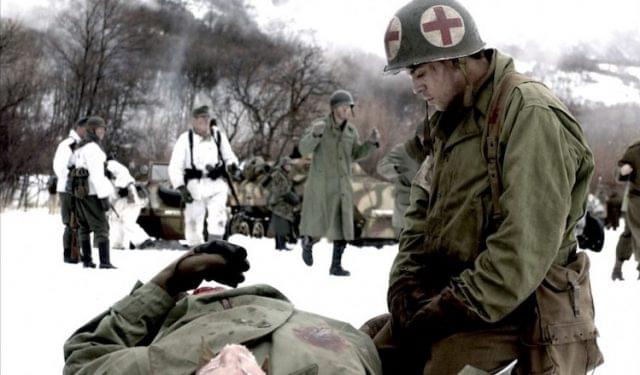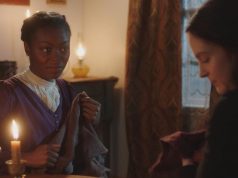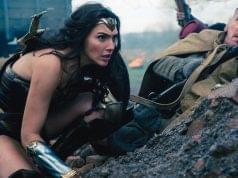
Within the genre of films by Mormons, about Mormons, “Saints and Soldiers” is easily the best. It is so superior on almost every level, especially in its technical aspects, that it puts hastily assembled drivel like “Handcart” and “The Home Teachers” to even more shame than they were already put to.
Take it out of the genre comparison and it still holds up. Intelligent, mature and thoughtful, it is one of the better films of any kind that you’ll see this year.
On Dec. 17, 1944, German soldiers opened fire on a group of unarmed American prisoners near the Belgian town of Malmedy, killing 86 of them. “Saints and Soldiers” opens with this massacre and follows a handful of U.S. soldiers who escape into the woods. There is Sgt. Gunderson (Peter Asle Holden), now the de facto commanding officer of the little group; Louisiana boy Kendrick (Larry Bagby), who is going through serious nicotine withdrawal; Brooklyn native Gould (Alexander Niver); and Greer (Corbin Allred), nicknamed Deacon for his religious practices.
Deacon doesn’t drink or smoke, he carries a little “Bible” around with him, and he was a missionary in pre-war Germany. Though the word “Mormon” is never used, it’s clear that’s what he is, though I suppose a non-Mormon viewer might take him for a Jehovah’s Witness or a fundamentalist Christian. (Those of us in the know catch the giveaway: He’s from Snowflake, Ariz., where EVERYONE is Mormon.)
While hiding from the Germans and still deciding on a course of action, the band finds Oberon Winley (Kirby Heyborne), a British paratrooper who has landed in their midst. He has critical information that he must get to the nearest Allies command post before the Germans cross the Muse River. And so the plan is set: Get there before the bad guys do.
Through snow, cold and under the constant threat of being found by the Germans, the group trudges toward safety. But Deacon, the best marksman in the group, hasn’t slept in several days, and he is haunted by something, remembrances he keeps having of an earlier miscalculation. Gould, in particular, is mistrusting of Deacon, given his previous association with and affinity for the German people.
The performances are solid all around, particularly from Corbin Allred as the tormented Deacon and Alexander Niver (who played the little boy on “Charles in Charge” in the ’80s) as Gould. None of the performances are maudlin or melodramatic, even when the events are dire; the tendency to overact in highly dramatic situations is repressed.
Geoffrey Panos and Matt Whitaker’s screenplay is tightly written, drawing the characters with enough strokes to give them personality but not weighing the thing down with needless exposition or backstory. It explores the inherent conflict between religion and war, the idea that one must sometimes give up one’s personal responsibility in order to fight for something bigger, even if it means doing things one is normally opposed to.
The director is Ryan Little, who also made the little-seen but commendable “Out of Step” (2002). Little acts as cinematographer, too, and “Saints and Soldiers” is a highly polished, visceral film in that regard. The tone is intense and atmospheric; still, while distinctly “light” moments are few, the film nonetheless is not oppressive or dreary. It is dramatic, in the most complimentary sense of that word. It engages the emotions and the senses subtly and expertly.
A- (1 hr., 30 min.; )





